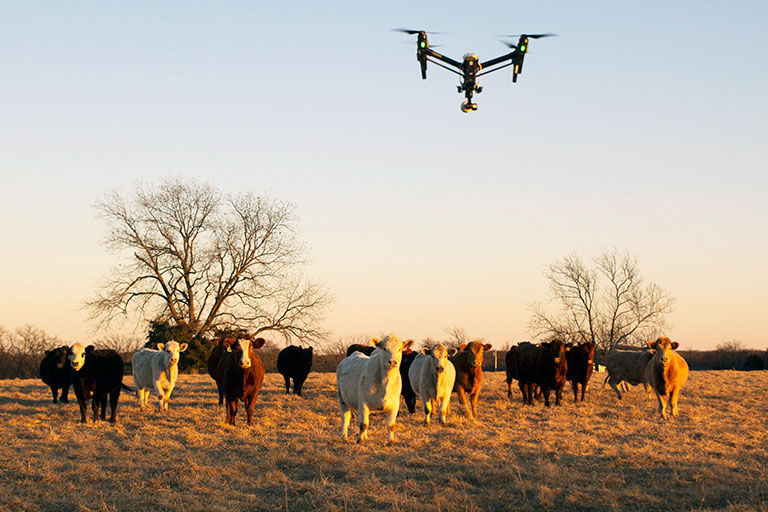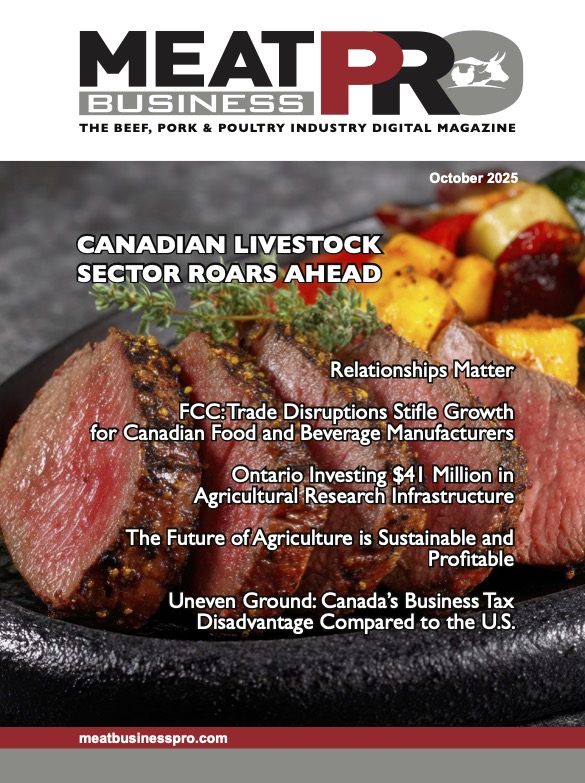Drones, Satellites and Artificial Intelligence: The Farmer’s New Reality

Whenever I hear the phrase Artificial Intelligence in the same sentence as drones and satellites, I’m not sure if the actual definition of “AI” is accurate. For me, I conjure up the image of Haley Joel Osment playing that synthetic boy looking for his mother in Steven Spielberg’s movie
by Cam Patterson – Canadian Meat Business exclusive
Perhaps when we refer to it’s role in modern farming and agriculture, the more apt portrayal is the recent Blade Runner movie, where the protein famer works in a containment module as an air-car passes overhead, and Ryan Gosling appears as the Replicant – virtually an “AI” cop.
As much as that is science fiction in a dystopian world, the idea of the farmer of the future might not be too far fetched beyond the movie. Just because we have smart tech and computers that can analyse farm fields and livestock from space today, does not really mean it’s actually AI. But it could be well on its way.
Drover’s Magazine, a U.S. based beef industry magazine and website, ran an article recently whereby JBS, one of the largest meat processors in the world, announced their South American operation was using satellite technology to monitor 450,000 acres of Brazil to ensure they are not sourcing cattle from deforested areas. JBS Chief Executive Gilberto Tomazoni told Drover’s, “We need to offer what the consumer wants. We cannot do that without worrying about the environment and animal welfare. This is fundamental to our business.”
“The harsh reality is food production is quickly colliding with a critical mass point measured against global population estimates of 10 billion by 2050”
While we should all applaud a leader like JBS taking the initiative to be proactive about environment and sustainable practices, we should wonder just how far technology has gone with respect to the farm and agriculture. When it comes to science and technological advancements since the industrial boom of the 1900s, it has always raised the age-old question of when “we should” and when “we shouldn’t”. In other words when science is going so far as to actually be detrimental to an industry, and since we’re talking about agriculture then let’s be specific – replacing jobs with automation, machines and computers.
Don’t get me wrong. There have been some remarkable strides in the last few years with farm and agriculture technology, all on the heels of the sustainability programs and campaigns, and climate change awareness and initiatives. And I’m one of those who believes we’re long overdue in paying attention to how we’re using our planet’s resources and how to ensure it’s still around for our children. The harsh reality is food production is quickly colliding with a critical mass point measured against global population estimates of 10 billion by 2050. That’s close to double the current population, so double the amount of food consumption without a way to double the land yield to raise, cultivate, and procure enough food to feed the planet. So, ultimately, science and tech is the ace up our sleeve in a manner of speaking.
Regardless of the pros versus cons conversation around agriculture technology, some advancements are making it into science journals all around the world. Many have already provided regular farmers with unprecedented macro-level insight previously the luxury of only the mammoth corporate mega farms. The playing field is more level and the science more affordable, and ultimately in many countries, more funded.
Let’s look at some advancements yielding astounding results both pro and con.
Drones, or UAV’s (Unmanned Aerial Vehicles) are by and far yielding the most practical use on today’s farms. Despite the controversial reputation drones have gotten from irresponsible use, there is a practical application to these small wonders that is making an undeniable mark in agriculture. Companies are springing up all over the world with advanced multispectral photographic and sensor technology that has given the agriculture industry an edge in precision farming.
Livestock management has definitely benefited from drone use. RFID tag frequency range has increased and now drones can pinpoint the actual animal, which for many a rancher in calving season, is an invaluable tool. Using Photo Orthormosaics – essentially flying a predetermined grid – and when outfitted with 3D and infrared cameras, the farmer can monitor herd health and development, showing an individual animals muscle density mass and assimilating the data to assist in determining the best time for feedlot sales.
Infrared cameras can also gauge animal sickness and find animals under foliage while also collecting data readings of the pasture, assimilating real-time data into computer graphic layers measuring Crop Performance, Soil Imagery and Class, Photosynthesis and Phosphorous Content, Nitrogen Content, Fertilizer Levels, Pest Infestation Matrix, Chlorophyll Absorption, Water Content, and Yield to Acre Ratios.
So essentially the same drone used to find cattle can measure the pasture by simply changing the payload with a multispectral camera. Thermal Imaging cameras can actually perform infrared scanning of cow udders to spot the bacterial infection that commonly leads to Matitis, which is a huge advancement for the dairy industry.
There are even Fitbits for cattle and pigs, essentially smart collars that track health, stress, and movement to consumption and fertility. Sensors and remote handheld cow breath meters can show elevated levels of acetone which could signal infections, and give the farmer advance warning, thus not only catching disease before spreading to an entire herd, but also minimizing antibiotic use.
Audio health monitoring is being used in pig barns, detecting coughs, which could signal early virus detection for PEDv, African Swine Flu as well as a whole host of other pathogens that end up costing the industry hundreds of millions of dollars and result in less antibiotics administered. As well Automated Behavior Analysis cameras have become widespread applications to track and monitor animal behaviour in pig and chicken barns. The use of 3D camera technology allows for heat signature data recognition to gauge health and weight estimates without personal contact with the animal. There is even testing happening to have camera facial imaging recognition do away with common animal markers like ear tags and tattooing.
The digital capture from drone and fixed cameras in barns and on farmlands combined with home-base computer software is so advanced and precise that these machines can in fact synthesize data and make decisions on that data when it comes to alerting of sick animals, triggering feeding operations remotely, or for crop farmers, activate sprinklers; even pinpointing which plant requires more watering. This is the point where the “AI” definition is hitting close to home.
However, the detractor to advance science essentially taking the guesswork out of farming is how close we are to removing essential jobs. Since that is the tent pole for the world’s economic stability, the con to all of this futuristic precision farming is without jobs no one can buy the food and the economy won’t survive. Thus the science won’t matter without a practical plan to sustain employment, which highlights the inevitable social and ethical implications of “AI” run farms.
The transportation industry is naturally keeping a keen eye on the Food to Miles issue because this sustainable initiative is designed to phase out produce and livestock transports. Even if the trucking industry can get electric, self-driving trucks to actually work – which they are actively pursuing to ensure less carbon footprint from their industry – it will still result in the loss of an invaluable workforce.
The same can be said for the farmer. John Deere recently released a video commercial highlighting their FarmForward 2.0 concept of the future farmer. It plays more like a Ridley Scott movie but definitely depicts where we are headed. The pros do outweigh the cons if it really does play out as the video shows. Regardless, it’s worth watching.
Vertical farming and hydroponic habitats are not necessarily a new idea, but in the new tech age of growing produce in hyper-ideal conditions of artificial lights and climate controlled rooms looks more like a scene from the Martian than actual farming. These new facilities are springing up in cities and regions where that particular produce would normally not grow, subsequently doing away with the need for transports to get it from the field to the stores. Because they can be tended and farmed 24 hours a day, they can yield more produce than a conventional farm field, however only certain plants prove to be profitable to grow in this manner – for the time being.
This is also true for the fish industry where some of the most remarkable advancements are happening with inland saltwater fish farms. And here is a surprising statistic, farmed fish consumption has surpassed beef consumption globally. That shouldn’t come as a surprise but for us Canadian born and bred red meat eaters, that’s shocking! Regardless, at a ground breaking fish farm lab in Baltimore, MD they have designed the first ever, completely self-reliant, artificial ocean eco-system environment in the world – absolutely no fish waste, carbon emissions, or any sign of climate change footprint is emitted from the plant. They are successfully raising ocean stocked fish for local consumption, and of course, doing away with the need for refrigerated trucks to get fish to market in timely fashion.
In the scientific long run, the real ground breaking science that could save agriculture and the world food crisis sure to come is advanced GMOs. Companies like DuPont and Syngenta are at the forefront of this advanced technology with synthesized, drought resistant corn called AquaMax and Artisian. Applying this science to other crops has the potential to lead to substantial crop yields for yams and potatoes for example. Then there is rice, which has already plateaued the yield to land ratio, meaning the maximum amount of yield per acre of land has already been attained. The C4 Rice Project involving multiple countries is working to develop a new strand of high output rice plant with a 50% yield increase. Even pigs are being genetically modified with certain gnomes to guard against disease – specifically PEDv and ASF.
I haven’t even touched on farming robots, but that feels a little too close to real AI. But rest assured that reality is quickly becoming commonplace on the farm and food processing factory floors.
Which brings me back to the farmer and all this technological advancement. What is concerning is the farmer to consumer ratio that points to an alarming trend in farming. Around the turn of the century 11 million farmers and agriculture workers in the U.S alone generated food for an average of 73 million people. Today only 6.5 million farmers and workers supply food to 321 million. That statistic should set off alarm bells in any food producing industry because science, automation and robotics are already replacing millions of jobs in the agriculture sector. At this rate, no workers will be needed by 2050.
I’m reminded of an article I did on Dr. John Church a few years ago. He is an associate professor at Thompson Rivers University who was working on a drone program and summed up the role of technology in the farmer/rancher’s life very well. He said, “Ranchers do an amazing job of eyeballing their pastures, but that is not a science. What we would like to do is give those ranchers quantitative tools to better help them ‘eyeball’ what is going on in their fields and on their ranch. This is key to the success of this technology.”
So, keeping an eye on agricultural sciences and the balance between true sustainable and enhanced food production, and the health of an industry workforce, should also be part of any advanced research.












